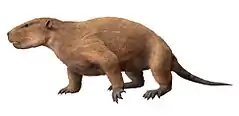| Corriebaatar Temporal range: latest Barremian | |
|---|---|
 | |
| Three views of the holotype tooth | |
 | |
| Reconstruction of the referred jaw | |
| Scientific classification | |
| Domain: | Eukaryota |
| Kingdom: | Animalia |
| Phylum: | Chordata |
| Class: | Mammalia |
| Order: | †Multituberculata |
| Suborder: | †Cimolodonta |
| Family: | †Corriebaataridae Rich et al., 2009 |
| Genus: | †Corriebaatar Rich et al., 2009 |
| Species: | †C. marywaltersae |
| Binomial name | |
| †Corriebaatar marywaltersae Rich et al., 2009 | |
Corriebaatar is an extinct genus of multituberculate mammals. It contains the single species Corriebaatar marywaltersae and represents the first evidence of Australian multituberculates.[1] It is known from fossils found in the Wonthaggi Formation date back to the Early Cretaceous (latest Barremian ~ 125 million years ago).
Discovery
The species Corriebaatar marywaltersae was discovered in 2009 based on the discovery of a well-preserved fourth premolar found in Victoria, Australia at the Flat Rocks fossil site. It was hypothesized to represent a cimolodontan multituberculate mammal as opposed to a new, unrecognized lineage. The 2009 specimen was the holotype and the only known remains of the species until a second specimen of C. marywaltersae was discovered at the same site and described in 2022. The second specimen was two pieces of the lower jawbone that preserved both the fourth premolar and the first and second molars.[2]
Taxonomy
It is placed as the only member of the family Corriebaataridae. Corriebaatar was placed in the 2022 study as a derived multituberculate belonging to Cimolodonta, and possibly closely related to Ferugliotherium from the Late Cretaceous of Argentina.[2]
See also
References
- ↑ Rich, T.H., Vickers-Rich, P., Flannery, T.F., Kear, B.P., Cantrill, D.J., Komarower, P., Kool, L., Pickering, D., Trusler, P., Morton, S., van Klaveren, N., and Fitzgerald, E.M.G. 2009. An Australian multitubercular and its palaeobiogeographic implications. Acta Palaeontologica Polonica 54(1):1-6.
- 1 2 "Second specimen of Corriebaatar marywaltersae from the Lower Cretaceous of Australia confirms its multituberculate affinities - Acta Palaeontologica Polonica". www.app.pan.pl. 2022. Retrieved 2022-04-01.

